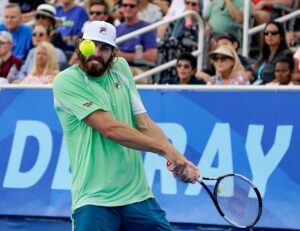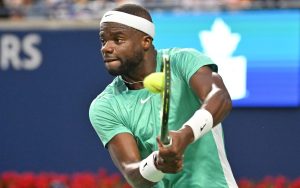It may seem outrageous to many to suggest that Pete Sampras is still the greatest of all time. After all, his 14 Major titles is now only good enough for fourth placed in the list, behind the Big Three of Roger Federer, Rafael Nadal and Novak Djokovic. And perhaps more importantly still, whilst the three players who have dominated this generation have all won all four Grand Slams at least once, Sampras never even reached the final at the French Open.
So yes, at first glance, this sounds like crazy talk. But is Sampras’ case stronger than it appears on paper? Well, just by looking at the numbers Sampras would have to be ruled out. But to compare achievements across generations requires a more nuanced approach, one that involves more than just counting titles. Instead, as with Nadal and Djokovic before him the ultimate question is: what are Sampras’ achievements that set him apart from his peers?
Sampras finished as year-end #1 six times in a row
This unprecedented achievement by Sampras often gets undervalued, largely because the debate around the greatest of all time typically tends to focus on Major titles won. But does that make sense? It might well be argued that it is more difficult to become the world #1 than to win a Grand Slam. The numbers certainly show as much. Since the introduction of computerised rankings in 1973, 54 players have won a Major title, but only 26 have held the #1 ranking.
Moreover, whilst 25 players reigned as Major champions without ever reaching the rankings penthouse, only one player – Marcelo Rios – has ever become world #1 without ever winning a Major.* And if you are still not convinced that reaching the top spot is harder than winning a Major then ask Guillermo Vilas. The Argentine won four Majors, two in 1977, but never made it to #1. Mark Edmondson, meanwhile, won the 1986 Australian Open but never broke into the top ten.
This should not be a surprise. To win a Major, a player need only find their best tennis for a relatively short period of time, never more than two weeks and often shorter, but to claim the #1 ranking requires consistent excellence. Holding the #1 ranking demonstrates that a player topped the field not just for two weeks, but for a whole year. It appears then that Sampras, who finished as year-end #1 a record six consecutive times, may not be getting the acclaim he deserves for that accomplishment.
Sampras is the most dominant player of all time
Comparing players of different generations is always a challenge. The obvious way of doing it is to compare their achievements in terms of numbers of titles won, years ended as world #1 and so on and so forth. But there are two different ways of comparing those numbers. The usual manner is to simply compare total numbers, e.g. Federer has won 20 Grand Slams and Sampras 14 ergo Federer is the more successful player.
The second, and perhaps more useful way, is to situate those numbers in their proper context. What is important here is to set a frame of reference, which can be achieved by asking the following question: how dominant is/was a certain player in his own generation? That is, how successful was a player compared to their main rivals during the player’s own career?
To see this idea in practice, the achievements of eight all-time greats: Jimmy Connors, Bjorn Borg, John McEnroe, Ivan Lendl as well Sampras, Federer, Nadal, and Djokovic, have been compared over the period between each player first achieving a top ten ranking and when they last left that elite number.
Connors’ top-10 years: 1973-1988
Let’s start with Connors. 1973 was the first year he finished in the top 10; 1988 was the last. Let’s see how he fared compared to what his main rivals achieved during that period. Connors’ top-10 years includes five consecutive finishes as year-end #1 and 268 weeks atop the rankings, not to mention his eight Majors in a total of 26 big titles. However, as remarkable as these achievements are, Connors doesn’t clearly outperform his main rivals during that period, winning fewer Majors than Borg (11) and fewer big titles than Borg (28), McEnroe (29) and Lendl (29).
Borg’s top-10 years: 1974-1981
How about Borg? He wasn’t that dominant either. True, he won a staggering 11 Majors from 1974 to 1981, more than anybody else, but that did not translate to dominance of the rankings, as he finished as year-end #1 just twice in that period.
McEnroe’s top-10 years: 1978-1989
McEnroe had a run of four incredible years between 1981 and 1984, when he clearly dominated the field. But his dominance was short-lived with Lendl equalling some of his feats (four year-end #1 and seven Majors) and surpassing other marks, notably weeks as #1 and big titles in that period.
Lendl’s top-10 years: 1980-1992
During his top-10 years – with four year-end and 270 weeks as #1, plus eight Majors in a total of 35 big titles, nobody performed better than Lendl. However, with McEnroe also having four year-end #1 finishes and six Majors during this period, Lendl’s dominance can hardly be considered to be unrivalled.
Big Three era
Let’s skip past Sampras for now and jump directly to the trio of Federer, Nadal and Djokovic. As their careers almost overlap, we can simplify and have one table for the three of them.
| 2003-2020 | Year-end #1 | Weeks as #1 | Majors | Tour Finals | Master 1000 | Big Titles |
| Federer | 5 | 310 | 20 | 6 | 28 | 54 |
| Nadal | 5 | 209 | 19 | 0 | 35 | 54 |
| Djokovic[2] | 5 | 282 | 17 | 5 | 34 | 56 |
When we look at these jaw-dropping numbers, we are all tempted to say that we are before the three best tennis players of all time. But it is important to note that whilst they have comprehensively dominated the field collectively, none of them can be said to have clearly and completely dominated the others, so close are their respective marks.
Sampras’s top-10 years: 1990-2002
So last, but not least, on to Sampras. Sampras’ impressive collection includes: six year-end and 286 weeks as #1; 14 Majors in a total of 30 big titles. But what’s even more impressive is to see how much more he achieved than his contemporaries. For instance, Andre Agassi – his closest rival – managed to win only half as many Majors, while the other big winners of this period are even further behind: Courier (four); Edberg (three); Kuerten (three); Hewitt (two).
And his dominance of the world rankings is even more stark. Sampras finished as year-end #1 six times, with Hewitt and Edberg, with two year-end #1 finishes apiece, his only rivals in that metric. He also held the #1 ranking in a vice like grip during the era. Whilst he racked up 286 weeks atop the rankings, no one else managed more than Agassi’s 87. The table below reveals just how dominant the great American was in his era.
| 1990-2002 | Year-End #1 | Weeks #1 | Majors | Tour Finals | Masters Series | Big Titles |
| Sampras | 6 | 286 | 14 | 5 | 11 | 30 |
| Agassi | 1 | 87 | 7 | 1 | 15 | 23 |
| Edberg | 2 | 72 | 3 | 0 | 4 | 7 |
| Courier | 1 | 58 | 4 | 0 | 5 | 9 |
| Kuerten | 1 | 43 | 3 | 1 | 5 | 9 |
| Hewitt | 2 | 58 | 2 | 2 | 1 | 5 |
With the notable exception of Masters Series titles, where Agassi has the advantage, Sampras not only leads every big category, but does so with a very comfortable margin.
Conclusions
This incredible performance relative to his peers whilst he was a top-ten player gives us a whole new dimension to Sampras’ achievements and may well redraw the picture in terms of the GOAT discussion. Federer, Nadal, and Djokovic, may all have more big titles in absolute terms than Sampras, there’s no denying that. However, it’s also true that they had to roughly divide the pie by three, none of them being able to be declared – without hesitation or huge polemics – the best.
In contrast, Sampras’ rule of his own era was all but unchallenged. Indeed, in that regard his achievements are unmatched through the entirety of the Open Era. So, if you think that the GOAT is about dominance over one’s peers, search no more: the GOAT answers to the name Sampras.
*Editor’s note: Ivan Lendl became world #1 in 1983 before winning his first Grand Slam, but went on to win eight over the course of his career.
As Djokovic debuted as top-10 only in 2007, his table would read as follows.
| 2007-2020 | year-end #1 | weeks #1 | majors | tour finals | master series | big titles |
| Djokovic | 5 | 282 | 17 | 5 | 34 | 56 |
| Nadal | 5 | 209 | 17 | 0 | 29 | 46 |
| Federer | 2 | 158 | 11 | 3 | 16 | 30 |
In this case, although Federer would fall far behind, Nadal would still be neck and neck with him, maintaining the overall conclusion.
Main photo:
Embed from Getty Images






